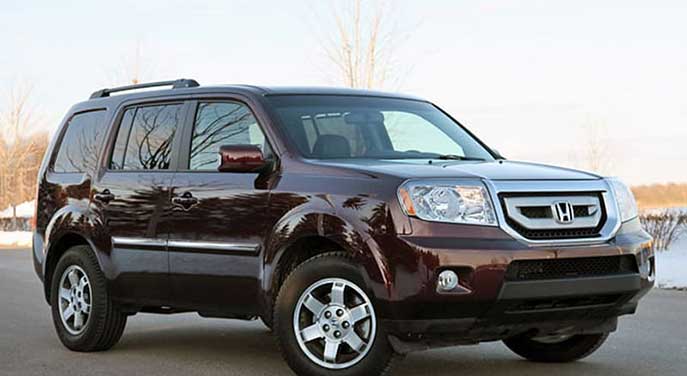
The Pilot featured a chunky body style with one of the least appealing front grilles in the industry
Like its upscale brethren – the Acura MDX – the 2011 edition of the Honda Pilot was a candidate for one of the homeliest models in the SUV market. Offered in four trim levels, it bore a strong resemblance to the Ridgeline pickup and featured a chunky body style with one of the least appealing front grilles in the industry.
Nice engine, though. Power was delivered by a 3.5 litre V6 that featured Honda’s variable valve timing feature as well as a variable cylinder management program.
On the highway, for example, the system deactivates up to three cylinders depending upon load and speed, and the whole thing is completely unobtrusive. A small “eco” light on the dash lets the driver know when the engine runs at maximum efficiency. Other manufacturers had similar systems, but Honda’s may have been the most seamless: it enabled the Pilot to claim a Tier 2/Bin 5 – or ultra-low emissions vehicle – emissions rating from the EPA.
There was one transmission choice: a five-speed automatic with a manual shift mode, and most trim levels of the Pilot came with a full-time all-wheel-drive system that featured a 4WD locking mode, accessed via a button to the right of the ignition switch. The base LX model was front-drive only, and the AWD system had a front-drive bias. All AWD versions also came with a hill start assist feature that prevents the vehicle from rolling backwards when you’re stopped on an incline. For the market it was aimed at and the duty it was intended for, this AWD system was more than adequate. As well, this iteration of the Pilot was much quieter in operation than the ones that came before it.
In terms of storage and carrying capacity, it had the customary fold-down second and third row seats and, with everything laid flat, boasted some 589 litres of cargo space. Everything works simply and is easy to get at, and the second row seats feature a separate lever for third-row seat access.
There were two safety recalls from Transport Canada and the U.S. National Highway and Traffic Safety Administration (NHTSA) for this vintage of the Pilot. One involved a possibly flawed drivers’ side airbag that may not deploy properly in a crash; the other concerned the driver and passenger front seat belts, which may have manufacturing flaws that could cause them to detach from their anchors in the event of a crash. Both of these glitches were easily repaired by dealers.
NHTSA also had six technical service bulletins out there for the 2011 Pilot. These ranged from a glitchy power sunroof that may open/close at random and draw power from the battery even when it’s closed, to a problem with the oil level indicator, to a tendency for some models to pull to the right during highway driving, to spark plugs fouling themselves. Some complaints from owners: “faulty spark plug(s),” “since the day we bought the car, the door locks squeal upon locking and unlocking,” “I have had multiple problems with the vehicle starting/cranking,” and “hit a bump in the road and the ABS and VSA (vehicle stability assist) wires were severed.” Some 18 complaints in all for this vintage of the Pilot.
Consumer Reports liked this one and gave the 2011 Pilot a “Good Bet” designation. There were some problems areas, notably the electrical system, brakes and body hardware, but it still garnered a “better than average” grade from C.R. Comments from owners: “has great power, even when towing,” “best vehicle I’ve owned,” “not wild about the styling,” and “may not be uber sexy,( but) wonderfully competent, safe and comfortable.”
Like most Honda products, this year of the Pilot has stood the test of time. Depending upon the model, it seems to be going from about the $10,000 range right up to the low $20,000s. The top of the line Touring is valued substantially higher than the base LX 2WD.
2011 Honda Pilot
Original Base Price: $36,820
Engine: 3.5 litre V6
Horsepower/Torque: 250 hp / 253 ft. lb;
Transmission: Five-speed automatic
Fuel Economy (litres/100 km): 13.1 city/9.1 hwy (AWD). Regular gas
Alternatives: Hyundai Vera Cruz, Chevrolet Traverse, Jeep Grand Cherokee, Kia Sorento, Mazda CX–9, Mercedes GLK 350, Nissan Murano, Saturn Outlook, Subaru Tribeca, Toyota Highlander.
Ted Laturnus has been an automotive journalist since 1976. He was named Canadian Automobile Journalist of the Year twice and is past president of the Automobile Journalists Association of Canada (AJAC). For interview requests, click here.
The views, opinions and positions expressed by columnists and contributors are the authors’ alone. They do not inherently or expressly reflect the views, opinions and/or positions of our publication.
© Troy Media
Troy Media is an editorial content provider to media outlets and its own hosted community news outlets across Canada.



